

In part 1, we looked at how Black should play against "standard" play by White, meaning that White simply develops his generals to good squares and castles. This is the way pros usually play this handicap. However, when a strong player really wants to win a game, he is apt to thwart Black's intended knight attack even if it means having to make unnatural moves, since the standard Black plan given in part 1 is so powerful. There are three primary plans available to White to foil the knight attack. Here we will look at the plan involving an early ... P2d together with gold or silver to 2c. We call these variations "Blocking Lines" since White usually blocks the exchange of the lance pawn as R1h can be answered by S2c or G2c. However in our first variation White defers ... P2d until after R1h has been played, gaining time but allowing the pawn exchange. The true blocking lines are usually well met by a quick climbing silver attack, aiming at an exchange of generals.
1... P3d 2 P7f P4d 3 P1f S3b (3... B3c 4 P1e S2b 5 R1h P2d 6 P1d Px1d 7 Rx1d P*1c 8 R1h S2c 9 S3h G3b 10 P4f G5b transposes to the main line of this variation.) 4 P1e G65b 5 R1h P2d 6 P1d Px1d 7 Rx1d S2c 8 R1h P*1c (8... P*1d looks better, but then Black attacks by P2f and S3h-2g-1f when the pawn on 1d is a target.) 9 S3h G3b 10 P4f (Since White has defended the edge well, Black attacks the center, which is weakened by the absence of the Silver from 4c. The pawn in hand is also useful for attacking the center.) B3c 11 S4g G54c 12 P3f P5d 13 N3g P1d 14 S5f S6b 15 R4h S5c 16 P4e
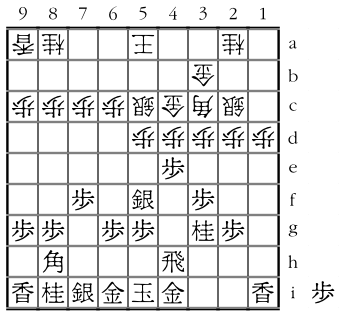
After 16.P4e
(Black refrains from the natural K6h-7h so that a later Bx8h+ by White will not be check and may allow Black to capture on 5c before recapturing on 8h.) K4a (White puts his king where his generals will protect it.) 17 G3h ! (guarding the loose knight before starting a fight, and also giving the king running room) K3a (17... Px4e ? 18 Nx4e Bx8h+ 19 Nx5c= favors Black.) 18 Px4d Sx4d (18... Bx4d 19 Bx4d Sx4d 20 Rx4d Gx4d 21 B*5c wins material) 19 S4e Sx4e (19... P5e 20 Sx4d Gx4d 21 N4e is strong) 20 P*4d !
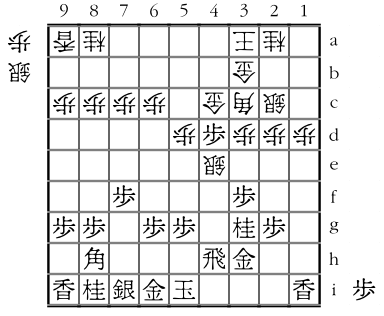
After 20.P*4d !
20... Gx4d 21 Nx4e. Black wins gold for knight. Analysis from move 11 on by Masaki Izumi, Pro 7 Dan.
1... P3d 2 P7f P4d (2... N3c 3 P2f P2d 4 P1f S3b 5 P1e S2c is another version of the Silver Blocking Line. Black plans S3h-2g-3f, N1g, G4h, P2e and a knight sacrifice on 1c. This plan works well against any blocking line when White plays ... N3c.) 3 P1f S3b 4 P1e P2d 5 P2f B3c (5... S2c is less accurate as Black can either play as in this variation or choose 6 P2e Px2e 7 Rx2e P*2d 8 R4e!! G3b 9 Rx4d!! when Black will get a promoted bishop and some pawns for the rook.) 6 S3h S2c 7 S2g (Black could also attack the fourth file as in the previous variation, but without a pawn in hand his attack might be less effective here.) G3b 8 S3f K6b 9 K6h (Another plan here is a quick attack by 9 G4h K7b 10 N1g, but 10... P4e!, aiming to exchange the bishop which is the intended target of the knight attack, is a bit messy.) K7b 10 K7h S6b 11 P9f (prepares a later B9g) P9d 12 G45h P5d 13 P2e (Black strikes before White can play S5c, which would spoil the B9g-3a+ plan used here.) Px2e 14 P1d!

After 14.P1d !
(this sets up an exchange of generals) Px1d 15 Sx2e P*2d 16 Sx1d Sx1d 17 Lx1d S*2c (17... P*1c 18 Lx1c+ Nx1c 19 P*1d L*1a 20 R1h N2e 21 P1c+ and Black will soon win the knight and/or the lance.) 18 P*1c (not 18 R1h? Sx1d!) P*1a (18... Sx1d 19 P1b+ and after taking the knight, Black's promoted pawn and White's offside silver give Black a nice advantage.) 19 R1h G2b (probably White should just allow the promotion on 1b, perhaps by 19... P4e.) 20 B9g !
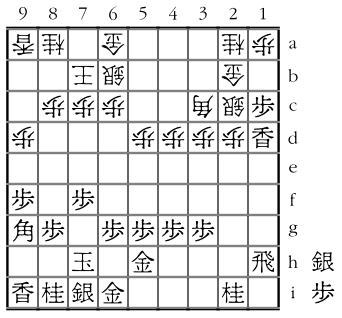
After 20.B9g !
20... P4e 21 B3a+ G3b 22 +Bx2a Bx9i+ 23 S8h +B9h 24 P1b+ Px1b 25 Lx1b+ P*1d 26 +L2b G3c 27 +Lx2c Gx2c 28 +B3b L*2b 29 S*9i +Bx9i 30 Sx9i. Black has a decisive material advantage. Analysis by Kazuharu Shoshi, Pro 6 Dan. He considers this to be White's best blocking line, since the gold blocking line allows Black to win gold for silver by the same plan as here, as shown below. I might even call this the "best line" of all; the lines given in the notes to move 17, 18, and 19 don't seem quite as bad for White as the main lines of the knight attack in Part I, since at least Black doesn't have a dragon yet.
1... P3d 2 P7f P4d 3 P1f G3b 4 P1e P2d 5 P2f (5 R1h? is pointless after 5... G2c) G2c (The main advantage of the gold blocking line is that a knight attack on 1c is less effective against a gold on 2c than against a silver there.) 6 S3h (Black aims for a climbing silver attack.) G5b 7 S2g S3b (7... G4c 8 S3f N3c 9 N1g S3b 10 G6h P5d 11 G4h K6a 12 P4f K7b 13 P2e Px2e 14 Nx2e P*2d 15 Nx1c+ leads to an exchange of knight and lance for a gold, which is a slight loss for Black, but afterwards Black attacks by R1h and P4e, which is hard to meet.) 8 S3f B3c (8... S3c 9 P2e Px2e 10 P1d! leads to an exchange of silver for gold, with White's bishop remaining as a target. The text move has the point that White can initiate a bishop exchange when appropriate.) 9 P4f K6a 10 K6h K7b 11 G45h P9d 12 P9f S6b 13 K7h P5d 14 G66h S5c 15 P2e Px2e 16 P1d !
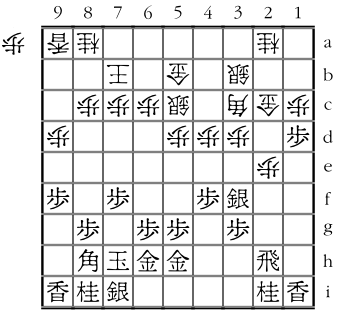
After 16.P1d !
16... Px1d 17 Sx2e P*2d 18 Sx1d Gx1d 19 Lx1d S2c (19... S*2c 20 P*2b! Bx2b 21 G*1b B3c 22 P*2b P*1a 23 Gx2a Sx1d 24 G3a S12c 25 P2a+ L*1d [to stop 26 N*1e] 26 N*4e! Px4e 27 +P2b winning material) 20 P*2b
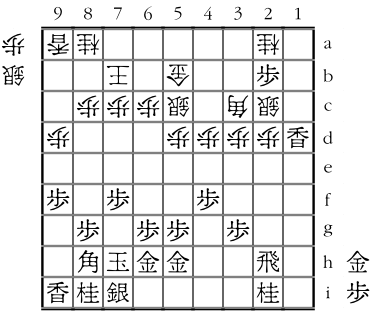
After 20.P*2b
Bx2b 21 G*1b B3c 22 L1c+ Sx1b 23 +Lx1b P*1f 24 +Lx2a P1g+ 25 Nx1g P*1f 26 N2e

After 26.N2e
B5a (26... P1g+ 27 Nx3c+ +Px2h 28 S*4c G6b 29 N*6e S6d 30 Bx4d with a decisive attack) 27 N1c+ P1g+ 28 R4h P5e 29 P4e G*5d 30 Px4d Sx4d 31 +L3a P*4e 32 +L3b S5c 33 +N2c P7d 34 P*4c B8d 35 +N3c P5f 36 P4b+ with advantage.
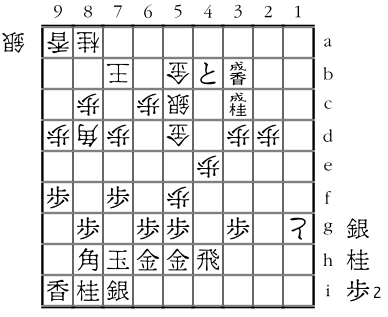
After 36.P4b+
This is analysis by the late Motoji Hanamura 9 Dan, considered the greatest handicap player of all time. In view of the complexity of this variation, it seems to be a decent choice for White at this handicap.